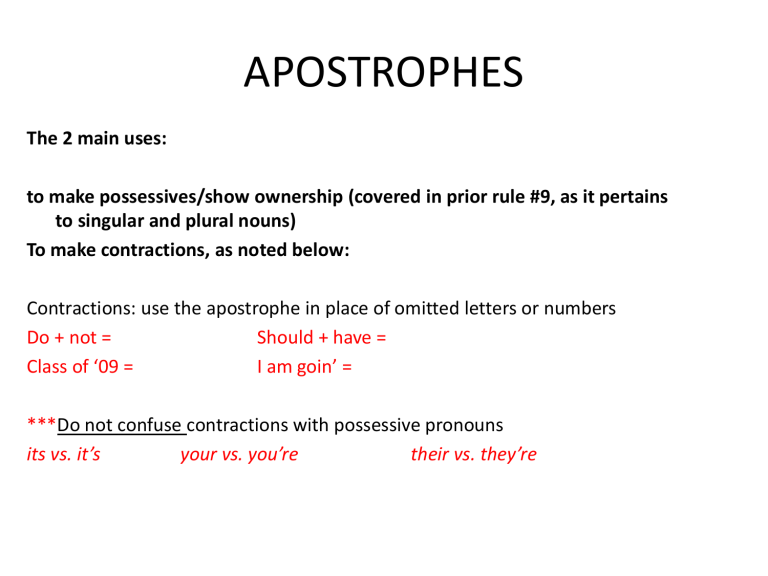APOSTROPHES

APOSTROPHES
The 2 main uses: to make possessives/show ownership (covered in prior rule #9, as it pertains to singular and plural nouns)
To make contractions, as noted below:
Contractions: use the apostrophe in place of omitted letters or numbers
Do + not = Should + have =
Class of ‘09 = I am goin’ =
*** Do not confuse contractions with possessive pronouns its vs. it’s your vs. you’re their vs. they’re
TITLES:
Quotation marks, underlining, italics
*** Use quotation marks when writing song titles, poem titles, short story titles, names of tv episodes, chapters of a book, and articles (whether magazine/encyclopedia/internet). Many also include essays as well.
Should Paul Sell Sue Two Ears of Corn Also?
You do this because they are part of a larger whole.
*** The larger whole gets underlined if handwriting or italics if your text is computer generated. It’s never both!
You’ve previously learned three ways to write the following IC’s:
Ex. Barney made BJ a birthday cake .
Babybop made him a card.
Barney made BJ a birthday cake , and Babybop made him a card.
Barney made BJ a birthday cake ; Babybop made him a card.
In #10, we suggested to use an adverbial conjunction after a semicolon as a transition that show sequence, comparison, contrast, etc.
Ex. He loves chocolate ; however, he likes vanilla much more.
He failed the test ; therefore, he will take a 2 nd chance.
But there is another way!
COLONS
*** Use a colon between two independent clauses if
(and only if) the second explains or summarizes the first.
Ex.
Garlic is used in many recipes: it enhances the flavor of starches.
COLON (CONT.)
*** Use a colon to introduce an idea or a list… with these requirements in your formal written work
1. the colon must follow a complete sentence
2. it cannot follow a verb
3. it cannot come in the middle of a phrase (like such as or for example)
No:
I think the best colors are: blue, red, and pink. They are the colors of: my car, my bedroom, and my favorite shirt.
Yes:
Rita wants the following for her birthday: a pony, a cake, and a doll.
SEMICOLON
What would this sentence say literally:
I brought my tent, my birthday present, a sleeping bag, S’mores, my favorite snack, and clothes on my camping trip.
Thus, use a semicolon to separate items when one or more of the units contains a comma which would cause confusion. This rule usually pertains to lists or phrases/clauses.
I brought my tent, my birthday present; a sleeping bag; S’mores, my favorite snack; and clothes on my camping trip.
As a reader, what is your understanding of the following?
The author states, “I decided… I wasn’t going” (26).
Similarly, what’s confusing with this statement?
“Last week I forgot to bring it,” the student added.
ELLIPSIS and BRACKETS
If you omit a word(s) from a quotation, you should indicate the deleted word(s) by using ellipsis marks, which are three periods (...) preceded and followed by a space.
For example:
In an essay on urban legends, Jan Harold Brunvand notes that "some individuals make a point of learning every recent rumor or tale ... and in a short time a lively exchange of details occurs" (78).
ELLIPSIS and BRACKETS
But if you were to add words… you should put brackets [ ] around the words you’ve added to indicate they are not part of the original excerpt. You might do this to clarify an item within the excerpt.
For Example:
“Last week I forgot to bring it [the homework],” the student added.
Charlie Manual said after the game, “He [Hamels] pitched his best game of the year when we needed it most.”
HYPHENS and DASHES
Dashes can be used (in informal work) to show clarification, interruption, or change of thought –like commas or parenthesis.
I went --by myself-- to the movies.
HYPHENS and DASHES
Hyphens are generally used to join words. Some of the most common hyphen rules are as follows:
Compound adjectives when they are a single idea and come before the noun
EX. A one-way street; chocolate-covered cherries; well-known artist
To spell out compound numbers between 21 and 99 and fractions
Words that may have an odd combo of letters
Ex. Semi-independent; shell-like
There are many, many, many more rules , especially with compound nouns, verbs, and phrases.
The best strategy is to use a dictionary!
HYPHENS and DASHES
Oddly…
When typing, a dash is two hyphens typed without spaces before, after, or between them. However, most modern programs change the -- to— automatically. In handwritten work make sure you distinguish it from the hyphen by making it longer!









